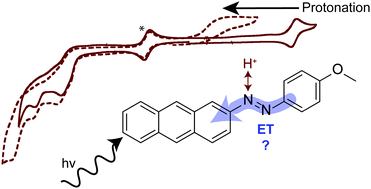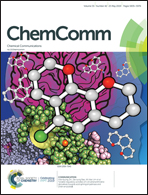Anthracene-based azo dyes for photo-induced proton-coupled electron transfer†
Abstract
Herein, we report a new donor–acceptor system for photo-induced proton-coupled electron transfer (PCET) that leverages an azo linkage as the proton-sensitive component and anthracene as a photo-trigger. Electrochemistry shows a change in the reduction potential with addition of acid. However, photochemistry is invariant to the absence or presence of acid. The anthracene and phenol/4-methoxyphenyl moieties of the azo dyes are highly conjugated, likely mitigating photo-induced charge transfer, despite sufficient driving force.

- This article is part of the themed collection: Frontiers in Proton Coupled Electron Transfer (PCET)


 Please wait while we load your content...
Please wait while we load your content...
